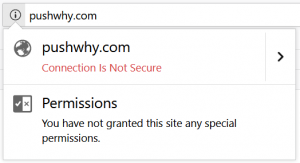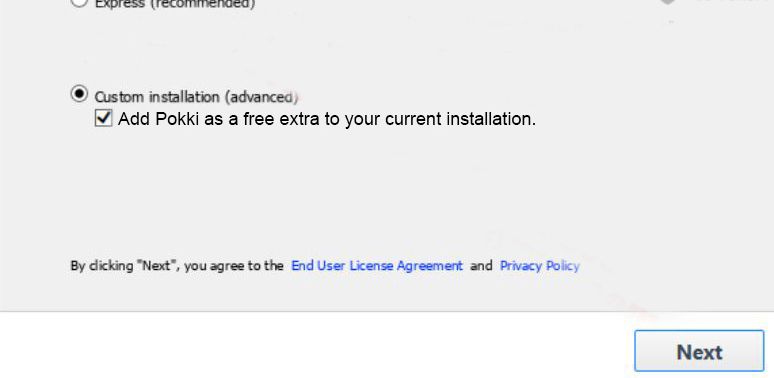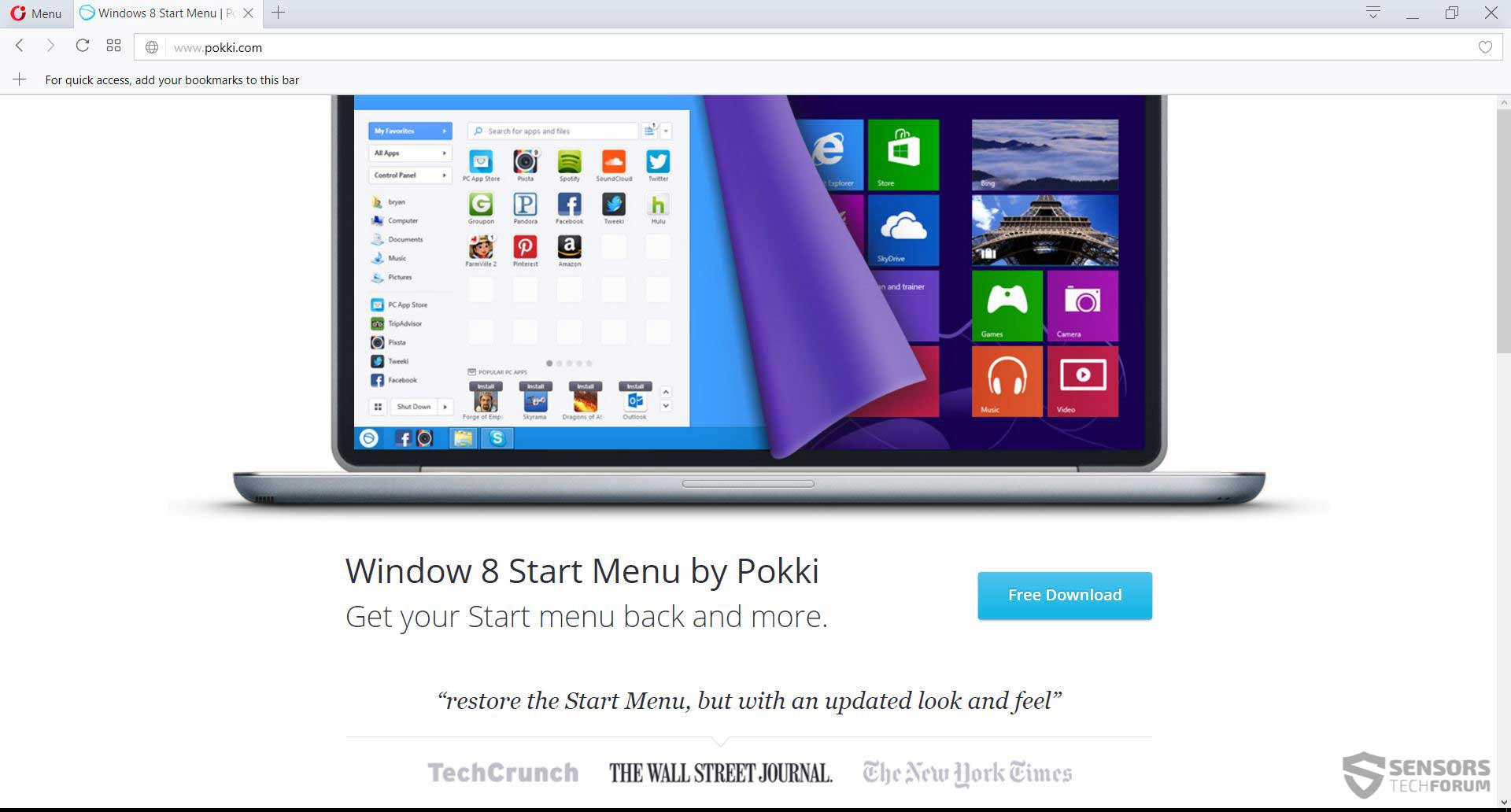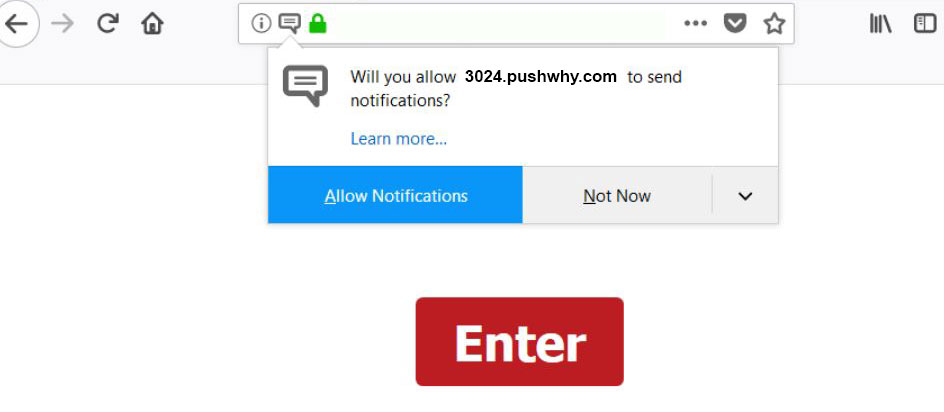 This article has been created in order to explain what is the pushwhy.com browser hijacker and how you can remove it from Google Chrome, Firefox, Internet Explorer or Edge Browsers.
This article has been created in order to explain what is the pushwhy.com browser hijacker and how you can remove it from Google Chrome, Firefox, Internet Explorer or Edge Browsers.
A new browser redirection virus has been reported by victims to be causing major browsing problems on the computers it has been installed on. The pushwhy.com “virus” is what many refer to as a browser hijacker – it “hijacks” your browser, changes it’s home page and adds registries and many files on your computer, that make this program very hard to delete. On top of that the pushwhy.com is part of the Pokki adware family of PUPs (Potentially Unwanted Programs), whose main goal is to show victimised computers a lot of advertisements and even cause browser redirects to websites that are unfamiliar and may turn out to be outright malicious. If you have problems with the Pushwhy.com adware, we strongly suggest that you read this article thoroughly.

Threat Summary
| Name | Pushwhy.com Redirect "Virus" |
| Type | Browser Hijacker |
| Short Description | Aims to modify the settings on your web browser in order to get it to cause browser redirects and display different advertisements. |
| Symptoms | Your web browser begins to display various types of online advertisements, which results in slowing down of your PC. |
| Distribution Method | Bundled downloads. Web pages which may advertise it. |
| Detection Tool |
See If Your System Has Been Affected by malware
Download
Malware Removal Tool
|
User Experience | Join Our Forum to Discuss Pushwhy.com Redirect "Virus". |

Pushwhy.com PUP – How Did I Get It
There are two main methods that may be used when it comes down to how Pushwhy.com spreads on victims’ computers. The software may be replicated as a result of software bundling, which means that it may be included as a seemingly useful program, like a Start Menu or other form of program in the installers of another free apps you may have downloaded from the web. In addition to this, the Pushwhy.com “virus” may also come as a result of Pokki Start Menu app being installed along the installation of another program. The program may be added in an install prompt which may appear in the “Custom” installation option, like the image below shows:
In addition to this, the program may be downloaded from Pokki’s website, where it can be directly added to your computer:
Another way via which you may have started seeing the Pushwhy.com web page on your browser is if you have other adware on your computer that may have downloaded and installed it without your permission. Usually such adware programs tend to obtain administrator-like privileges and then use those privileges to perform series of unwanted activities on the computers of victims. The outcome of this is often slow computer, which freezes at times and is cramped up with ads and browser extensions.

Pushwhy.com “Virus” – Activity and More Information
When Pushwhy.com browser hijacker is added on your computer, the domain may display a pop-up that may ask you if you want to accept any [wplinkpreview url=”https://sensorstechforum.com/agefeed-com-pushstat-com-push-notifications-virus-remove/”]push notifications. The main domain itself pushwhy.com may return nothing, but if it is combined with a custom URL caused by the Pokki adware running on your computer, you may be asked to allow or not allow notifications:
When the user accepts those notifications, the program may immediately begin to cause browser redirections on the browser. So far, the affected web browsers are among the following:
- Mozilla Firefox.
- Google Chrome.
- Microsoft Edge.
- Internet Explorer.
Once accepted, the push notifications may lead to tons of web pages for online betting, online shopping and other sites you may never heard of before. The ads may also resemble legitimate and big websites, like [wplinkpreview url=”https://sensorstechforum.com/remove-instagram-rayban-tag-scam-virus-pc/”]Ray-Ban, [wplinkpreview url=”https://sensorstechforum.com/nike-shoes-facebook-instagram-scam-virus-remove/”]Nike and other big brand names to trick victims to make a purchase via a fake, phishing page.
The main types of ads that may be caused as a results of PushWhy.com redirects, could be:
- Pop-ups.
- Browser redirects.
- Banners to be taken over on the sites you visit.
- Hidden buttons to cause redirects once you click on something you thought was a button of the site you have visited.
- Direct pop-ups showing up even if you are not using your browser.
The worst part about it is that PushWhy.com and other similar domains to it (pushnice.comSentand pushgaga.com) are labelled as insecure, as we have already checked:
This means that your connection to the site itself is not encrypted, making it open for hackers to use cookies and other tracking technologies to track your information. Your every online move may be tracked, more specifically:
- The sites you visit.
- The places you click on.
- Your online browsing history and bookmarks.
- Your search history on Google.
- Your downloaded files.
- What you type while on your browser.
- Saved passwords and logins on your browser.
- Saved financial information on your browser.
This is one more reason to consider removing the PushWhy.com – related software that may currently be residing on your computer. And what is more, the Pushwhy.com virus is also believed to be related to Pokki adware as users have already reported it. And Pokki is well known for having suspicious privacy policy practices that may result in the aggregation of different types of data from the computers their software is installed on:
In addition to this, the PushWhy.com may also establish connection with several different hosts, according to recent Hybrid Analysis report:
- 188.72.213.138 – URL SOLUTIONS INC.
- 93.184.220.29 – MarkMonitor, Inc.
- 88.85.66.235
If you have seen PushWhy on an affected computer, blocking those hosts in your firewall is also a good idea, after removing this unwanted software Is also a good idea.

Permanent Removal Steps for Pushwhy.com Redirect “Virus”
If you want to remove Pushwhy.com redirect from your computer, we strongly advise you to follow the removal instructions underneath this article. They have been created with the main idea to help you remove this browser hijacker either manually or automatically from your browser and machine.
If manual removal is what you want, then the first two removal methods are for you. However, for maximum effectiveness in removing Pushwhy.com redirect “virus”, we recommend that you follow the removal instructions that are underneath this article. They have been created with the main idea to help you delete this virus from any place it may reside. However, since such unwanted programs often leave behind files that are undesirable or the programs themselves are hard to delete, it is recommended to take a more professional and automatic approach. One such recommended removal method is to use a powerful anti-malware software. Such program guarantees to be able t remove this software from your computer automatically.
- Windows
- Mac OS X
- Google Chrome
- Mozilla Firefox
- Microsoft Edge
- Safari
- Internet Explorer
- Stop Push Pop-ups
How to Remove Pushwhy.com Redirect "Virus" from Windows.
Step 1: Scan for Pushwhy.com Redirect "Virus" with SpyHunter Anti-Malware Tool



Step 2: Boot Your PC In Safe Mode





Step 3: Uninstall Pushwhy.com Redirect "Virus" and related software from Windows
Uninstall Steps for Windows 11



Uninstall Steps for Windows 10 and Older Versions
Here is a method in few easy steps that should be able to uninstall most programs. No matter if you are using Windows 10, 8, 7, Vista or XP, those steps will get the job done. Dragging the program or its folder to the recycle bin can be a very bad decision. If you do that, bits and pieces of the program are left behind, and that can lead to unstable work of your PC, errors with the file type associations and other unpleasant activities. The proper way to get a program off your computer is to Uninstall it. To do that:


 Follow the instructions above and you will successfully uninstall most programs.
Follow the instructions above and you will successfully uninstall most programs.
Step 4: Clean Any registries, Created by Pushwhy.com Redirect "Virus" on Your PC.
The usually targeted registries of Windows machines are the following:
- HKEY_LOCAL_MACHINE\Software\Microsoft\Windows\CurrentVersion\Run
- HKEY_CURRENT_USER\Software\Microsoft\Windows\CurrentVersion\Run
- HKEY_LOCAL_MACHINE\Software\Microsoft\Windows\CurrentVersion\RunOnce
- HKEY_CURRENT_USER\Software\Microsoft\Windows\CurrentVersion\RunOnce
You can access them by opening the Windows registry editor and deleting any values, created by Pushwhy.com Redirect "Virus" there. This can happen by following the steps underneath:


 Tip: To find a virus-created value, you can right-click on it and click "Modify" to see which file it is set to run. If this is the virus file location, remove the value.
Tip: To find a virus-created value, you can right-click on it and click "Modify" to see which file it is set to run. If this is the virus file location, remove the value.
Video Removal Guide for Pushwhy.com Redirect "Virus" (Windows).
Get rid of Pushwhy.com Redirect "Virus" from Mac OS X.
Step 1: Uninstall Pushwhy.com Redirect "Virus" and remove related files and objects





Your Mac will then show you a list of items that start automatically when you log in. Look for any suspicious apps identical or similar to Pushwhy.com Redirect "Virus". Check the app you want to stop from running automatically and then select on the Minus (“-“) icon to hide it.
- Go to Finder.
- In the search bar type the name of the app that you want to remove.
- Above the search bar change the two drop down menus to “System Files” and “Are Included” so that you can see all of the files associated with the application you want to remove. Bear in mind that some of the files may not be related to the app so be very careful which files you delete.
- If all of the files are related, hold the ⌘+A buttons to select them and then drive them to “Trash”.
In case you cannot remove Pushwhy.com Redirect "Virus" via Step 1 above:
In case you cannot find the virus files and objects in your Applications or other places we have shown above, you can manually look for them in the Libraries of your Mac. But before doing this, please read the disclaimer below:



You can repeat the same procedure with the following other Library directories:
→ ~/Library/LaunchAgents
/Library/LaunchDaemons
Tip: ~ is there on purpose, because it leads to more LaunchAgents.
Step 2: Scan for and remove Pushwhy.com Redirect "Virus" files from your Mac
When you are facing problems on your Mac as a result of unwanted scripts and programs such as Pushwhy.com Redirect "Virus", the recommended way of eliminating the threat is by using an anti-malware program. SpyHunter for Mac offers advanced security features along with other modules that will improve your Mac’s security and protect it in the future.
Video Removal Guide for Pushwhy.com Redirect "Virus" (Mac)
Remove Pushwhy.com Redirect "Virus" from Google Chrome.
Step 1: Start Google Chrome and open the drop menu

Step 2: Move the cursor over "Tools" and then from the extended menu choose "Extensions"

Step 3: From the opened "Extensions" menu locate the unwanted extension and click on its "Remove" button.

Step 4: After the extension is removed, restart Google Chrome by closing it from the red "X" button at the top right corner and start it again.
Erase Pushwhy.com Redirect "Virus" from Mozilla Firefox.
Step 1: Start Mozilla Firefox. Open the menu window:

Step 2: Select the "Add-ons" icon from the menu.

Step 3: Select the unwanted extension and click "Remove"

Step 4: After the extension is removed, restart Mozilla Firefox by closing it from the red "X" button at the top right corner and start it again.
Uninstall Pushwhy.com Redirect "Virus" from Microsoft Edge.
Step 1: Start Edge browser.
Step 2: Open the drop menu by clicking on the icon at the top right corner.

Step 3: From the drop menu select "Extensions".

Step 4: Choose the suspected malicious extension you want to remove and then click on the gear icon.

Step 5: Remove the malicious extension by scrolling down and then clicking on Uninstall.

Remove Pushwhy.com Redirect "Virus" from Safari
Step 1: Start the Safari app.
Step 2: After hovering your mouse cursor to the top of the screen, click on the Safari text to open its drop down menu.
Step 3: From the menu, click on "Preferences".

Step 4: After that, select the 'Extensions' Tab.

Step 5: Click once on the extension you want to remove.
Step 6: Click 'Uninstall'.

A pop-up window will appear asking for confirmation to uninstall the extension. Select 'Uninstall' again, and the Pushwhy.com Redirect "Virus" will be removed.
Eliminate Pushwhy.com Redirect "Virus" from Internet Explorer.
Step 1: Start Internet Explorer.
Step 2: Click on the gear icon labeled 'Tools' to open the drop menu and select 'Manage Add-ons'

Step 3: In the 'Manage Add-ons' window.

Step 4: Select the extension you want to remove and then click 'Disable'. A pop-up window will appear to inform you that you are about to disable the selected extension, and some more add-ons might be disabled as well. Leave all the boxes checked, and click 'Disable'.

Step 5: After the unwanted extension has been removed, restart Internet Explorer by closing it from the red 'X' button located at the top right corner and start it again.
Remove Push Notifications from Your Browsers
Turn Off Push Notifications from Google Chrome
To disable any Push Notices from Google Chrome browser, please follow the steps below:
Step 1: Go to Settings in Chrome.

Step 2: In Settings, select “Advanced Settings”:

Step 3: Click “Content Settings”:

Step 4: Open “Notifications”:

Step 5: Click the three dots and choose Block, Edit or Remove options:

Remove Push Notifications on Firefox
Step 1: Go to Firefox Options.

Step 2: Go to “Settings”, type “notifications” in the search bar and click "Settings":

Step 3: Click “Remove” on any site you wish notifications gone and click “Save Changes”

Stop Push Notifications on Opera
Step 1: In Opera, press ALT+P to go to Settings.

Step 2: In Setting search, type “Content” to go to Content Settings.

Step 3: Open Notifications:

Step 4: Do the same as you did with Google Chrome (explained below):

Eliminate Push Notifications on Safari
Step 1: Open Safari Preferences.

Step 2: Choose the domain from where you like push pop-ups gone and change to "Deny" from "Allow".
Pushwhy.com Redirect "Virus"-FAQ
What Is Pushwhy.com Redirect "Virus"?
The Pushwhy.com Redirect "Virus" threat is adware or browser redirect virus.
It may slow your computer down significantly and display advertisements. The main idea is for your information to likely get stolen or more ads to appear on your device.
The creators of such unwanted apps work with pay-per-click schemes to get your computer to visit risky or different types of websites that may generate them funds. This is why they do not even care what types of websites show up on the ads. This makes their unwanted software indirectly risky for your OS.
What Are the Symptoms of Pushwhy.com Redirect "Virus"?
There are several symptoms to look for when this particular threat and also unwanted apps in general are active:
Symptom #1: Your computer may become slow and have poor performance in general.
Symptom #2: You have toolbars, add-ons or extensions on your web browsers that you don't remember adding.
Symptom #3: You see all types of ads, like ad-supported search results, pop-ups and redirects to randomly appear.
Symptom #4: You see installed apps on your Mac running automatically and you do not remember installing them.
Symptom #5: You see suspicious processes running in your Task Manager.
If you see one or more of those symptoms, then security experts recommend that you check your computer for viruses.
What Types of Unwanted Programs Are There?
According to most malware researchers and cyber-security experts, the threats that can currently affect your device can be rogue antivirus software, adware, browser hijackers, clickers, fake optimizers and any forms of PUPs.
What to Do If I Have a "virus" like Pushwhy.com Redirect "Virus"?
With few simple actions. First and foremost, it is imperative that you follow these steps:
Step 1: Find a safe computer and connect it to another network, not the one that your Mac was infected in.
Step 2: Change all of your passwords, starting from your email passwords.
Step 3: Enable two-factor authentication for protection of your important accounts.
Step 4: Call your bank to change your credit card details (secret code, etc.) if you have saved your credit card for online shopping or have done online activities with your card.
Step 5: Make sure to call your ISP (Internet provider or carrier) and ask them to change your IP address.
Step 6: Change your Wi-Fi password.
Step 7: (Optional): Make sure to scan all of the devices connected to your network for viruses and repeat these steps for them if they are affected.
Step 8: Install anti-malware software with real-time protection on every device you have.
Step 9: Try not to download software from sites you know nothing about and stay away from low-reputation websites in general.
If you follow these recommendations, your network and all devices will become significantly more secure against any threats or information invasive software and be virus free and protected in the future too.
How Does Pushwhy.com Redirect "Virus" Work?
Once installed, Pushwhy.com Redirect "Virus" can collect data using trackers. This data is about your web browsing habits, such as the websites you visit and the search terms you use. It is then used to target you with ads or to sell your information to third parties.
Pushwhy.com Redirect "Virus" can also download other malicious software onto your computer, such as viruses and spyware, which can be used to steal your personal information and show risky ads, that may redirect to virus sites or scams.
Is Pushwhy.com Redirect "Virus" Malware?
The truth is that PUPs (adware, browser hijackers) are not viruses, but may be just as dangerous since they may show you and redirect you to malware websites and scam pages.
Many security experts classify potentially unwanted programs as malware. This is because of the unwanted effects that PUPs can cause, such as displaying intrusive ads and collecting user data without the user’s knowledge or consent.
About the Pushwhy.com Redirect "Virus" Research
The content we publish on SensorsTechForum.com, this Pushwhy.com Redirect "Virus" how-to removal guide included, is the outcome of extensive research, hard work and our team’s devotion to help you remove the specific, adware-related problem, and restore your browser and computer system.
How did we conduct the research on Pushwhy.com Redirect "Virus"?
Please note that our research is based on independent investigation. We are in contact with independent security researchers, thanks to which we receive daily updates on the latest malware, adware, and browser hijacker definitions.
Furthermore, the research behind the Pushwhy.com Redirect "Virus" threat is backed with VirusTotal.
To better understand this online threat, please refer to the following articles which provide knowledgeable details.








